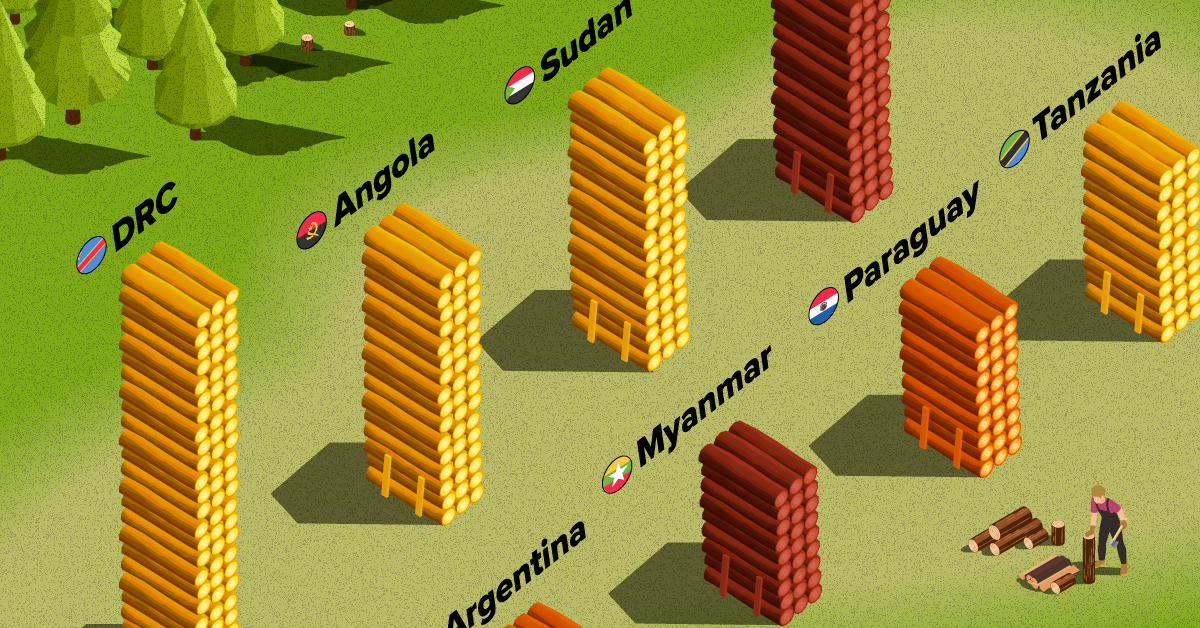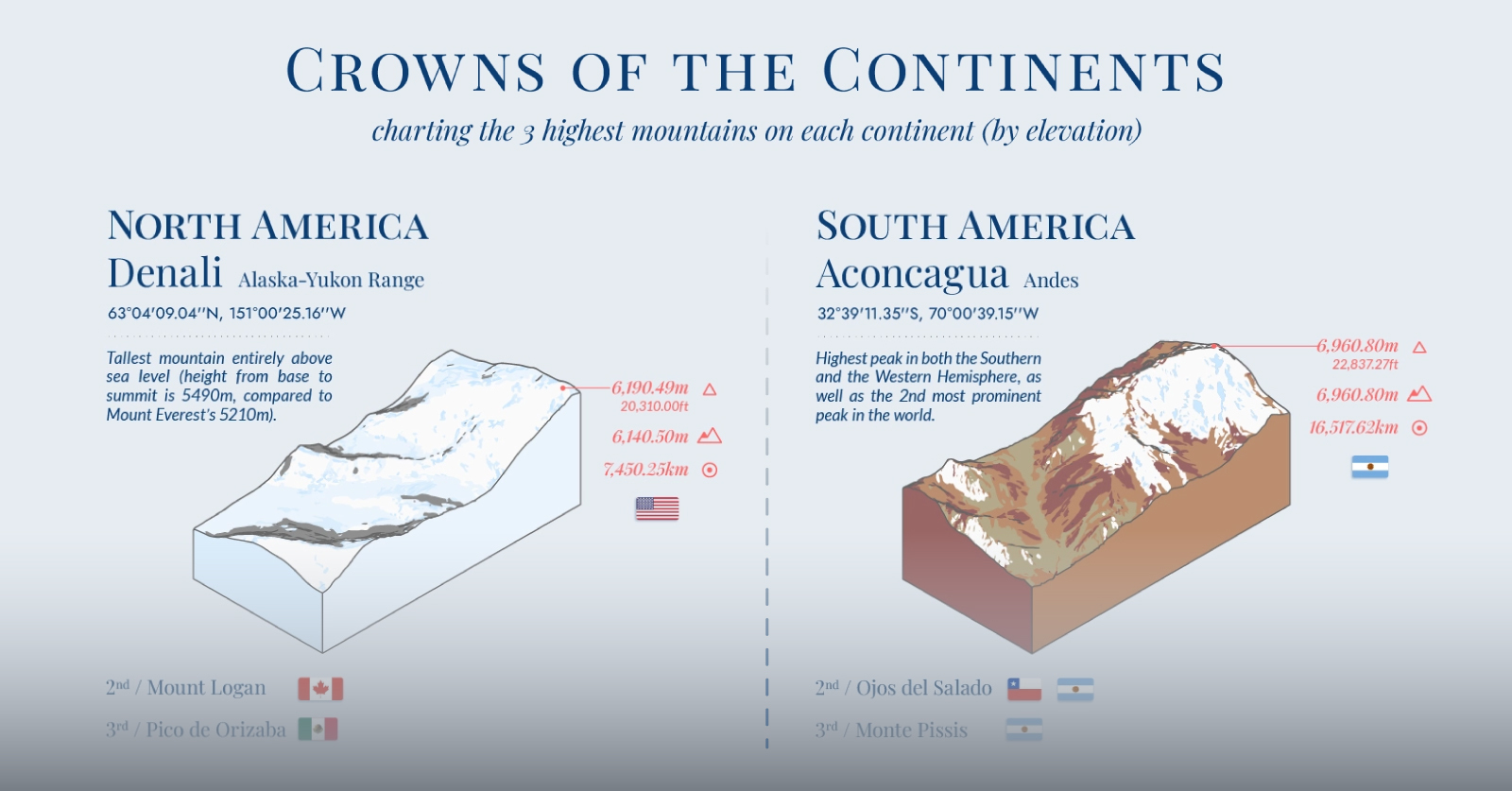Environment
Mapping the World’s Highest Mountains, By Continent
Click to view this graphic in a higher-resolution.
Mapping the World’s Highest Mountains, By Continent
From the snow-capped Himalayas in Asia to the dormant Mauna Kea in Hawai’i, mountains have long been a source of fascination for humans.
They are geological marvels, sacred spaces, and the crowning glory of nature and nations. And while there are mountain ranges found all over the world, a few peaks quite literally stand out from the rest.
In this graphic, Arijit Gupta uses data from various sources including Wikipedia, Peakbagger, and EarthENV to highlight three mountains that crown each of the world’s continents.
1. Asia
With its highest three peaks all surpassing 8,000 meters, Asia has the highest mountains in the world in terms of absolute elevation.
| Mountain | Range | Height |
|---|---|---|
| Mount Everest | Himalayas | 8,845m |
| K2 | Karakoram | 8,609m |
| Kanchenjunga | Himalayas | 8,586m |
Towering over the Himalayas, the famed Mount Everest on the border of China and Nepal is the highest mountain peak on Earth by elevation. Climbers train for months and, at times, years to scale this challenging peak.
Not far behind Mount Everest is the Karakoram range’s K2 between Pakistan and China. While its peak is a little over 200 meters shorter than that of Everest, more inclement weather locally is said to make it a lot more dangerous to climbers.
The main peak of Kanchenjunga, another Himalayan mountain between India and Nepal, stands tall at 8,586 meters. While this peak is the third-highest in the world, its range comprises four other peaks that are not far behind.
2. South America
South America’s crowning peaks are seen along the Andes Mountain range, starting with the highest mountain peak in the Southern Hemisphere—Aconcagua.
| Mountain | Range | Height |
|---|---|---|
| Aconcagua | Andes | 6,961m |
| Ojos del Salado | Andes | 6,893m |
| Monte Pissis | Andes | 6,793m |
Located in Argentina, Aconcagua stands at a staggering height of 6,961 meters above sea level. It is also the highest mountain peak in the Americas.
Ojos del Salado on the Argentina–Chile border is a close second in height. This peak ranks as the highest volcano in the world, with its upper reaches containing lava domes, lava flows, and volcanic craters.
Another Argentinian mountain, Monte Pissis, stands merely 100 meters lower than Ojos del Salado. At an elevation of 6,793 meters, it is still the third-highest mountain in the Western Hemisphere.
3. North America
Unlike the continents above, the highest mountains in North America are spread out across a few different mountain ranges.
| Mountain | Range | Height |
|---|---|---|
| Denali | Alaska | 6,190m |
| Mount Logan | St. Elias | 5,959m |
| Pico De Orizaba | Trans-Mexican Volcanic Belt | 5,636m |
The U.S.’s Denali in the Alaska Range is the tallest mountain in North America at 6,190 meters. Formerly called Mount McKinley, Denali’s subarctic location and elevation is said to make it the coldest mountain in the world.
Located in Canada’s Yukon Territory, Mount Logan is the second-highest mountain in North America. Thanks to a process known as tectonic uplifting, it is actually still increasing in height by about 0.35 mm each year.
Mexico’s Pico de Orizaba, a dormant volcano, comes in third. Though it is part of the far-away Trans-Mexican Volcanic Belt range, all of the continent’s largest mountains are part of the North American Cordillera of connected mountain ranges.
4. Africa
Africa is home to three of the world’s highest peaks, and some of the most diverse mountain-side climates surrounding them.
| Mountain | Range | Height |
|---|---|---|
| Mount Kilimanjaro | Eastern Rift | 5,895m |
| Mount Kenya | Eastern Rift | 5,199m |
| Mount Stanley | Rwenzori | 5,109m |
Tanzania’s Mount Kilimanjaro is the highest peak in Africa and the highest freestanding mountain globally. Climbing Kilimanjaro is a unique experience, as it takes you through five different ecological zones including rainforests, moorlands, alpine deserts, and glaciers.
Meanwhile, Africa’s second-highest peak in Kenya, its namesake Mount Kenya, actually has three distinct summits. It’s a UNESCO World Heritage Site and home to various wildlife species, including elephants and hyenas.
Following close is the Rwenzori Range’s Mount Stanley. Located on the border between Uganda and the Democratic Republic of the Congo, it is locally believed to be a sacred site where ancestors reside on the mountain’s peaks.
5. Europe
The Caucasus Mountains at the edge of Eastern Europe contains the continent’s highest mountains.
| Mountain | Range | Height |
|---|---|---|
| Mount Elbrus | Caucasus Mountains | 5,642m |
| Gora Dykh-Tau | Caucasus Mountains | 5,205m |
| Shkhara | Caucasus Mountains | 5,193m |
Mount Elbrus in Russia is number one with an elevation of 5,642 m. The mountain is a dormant volcano with a symmetrical double-cone shape, but since its most recent explosion was around 50 C.E., it is presently covered with snow and glaciers.
Nearby Goa Dykh-Tau is the second-highest mountain in Europe. It has a sharp, pyramid-like peak that rises sharply from its base, and is located just a few kilometers north of the Georgian border.
Just across the border on the southern side is Shkhara, the third-highest peak on the European continent. It is known for a distinctive double summit, with the western summit being slightly higher than the eastern one.
6. Oceania
While many of the above continents have high-ranking mountain peaks located in different countries, Oceania’s are all entirely within Indonesia on the island of New Guinea.
| Mountain | Range | Height |
|---|---|---|
| Puncak Jaya | Sudirman | 4,884m |
| Sumantri | Sudirman | 4,870m |
| Puncak Mandala | Jayawijaya | 4,760m |
Oceania’s highest peak is Puncak Jaya, also known by other local names including Carstensz Pyramid, the mountain of which Puncak Jaya is a distinct summit. It’s the world’s tallest mountain on an island, and reaching its summit is a challenging climb due to its remote location and difficult terrain.
Decades ago, second-place Sumantri was known as Ngga Pulu, and was higher than Puncak Jaya. However, that changed due to glacial melting since the 1850s helped isolate and clarify the local peaks of Carstensz Pyramid. Today, Sumantri stands tall at 4,870 meters as the second-highest on the continent.
To the East in the Jayawijaya range, Puncak Mandala is third on this list. But as a freestanding mountain, it is sometimes considered to be the second-highest peak in Oceania, while Sumantri is disqualified as an offshoot peak of Carstensz Pyramid.
Bonus: Antarctica
Though they weren’t mapped, Gupta also included data for the mountains in Antarctica, which are unlike any other mountains on Earth.
These mountains are relatively low-lying and often completely covered in ice and snow.
| Mountain | Range | Height |
|---|---|---|
| Vinson Massif | Sentinel | 4,892m |
| Mount Tyree | Sentinel | 4,852m |
| Mount Shinn | Sentinel | 4,661m |
The Vinson Massif contains the highest peak on Antarctica, known as Mount Vinson. Discovered in 1958, the mountain is a challenging climb with lots of icy terrain, and was the last of the Seven Summits to be ascended for the first time in 1966.
Mount Tyree is the second-highest on the continent and only 13 kilometers away from Vinson. It has an elevation just 40 meters shorter, but is also difficult to access.
Comparatively, Mount Shinn—the third-highest peak on the continent—is sometimes also summited by experienced mountaineers that come to Antarctica to climb Mount Vinson.

This article was published as a part of Visual Capitalist's Creator Program, which features data-driven visuals from some of our favorite Creators around the world.
Green
Ranked: Top Countries by Total Forest Loss Since 2001
The country with the most forest loss since 2001 lost as much forest cover as the next four countries combined.

Ranked: Top Countries By Total Forest Loss Since 2001
This was originally posted on our Voronoi app. Download the app for free on iOS or Android and discover incredible data-driven charts from a variety of trusted sources.
Forests are critical natural resources, often caught in the crosshairs of economic development. Thanks to expanding human settlement, agriculture, and industry, the world lost nearly 1 million square kilometers (km²) of forest cover since 2001.
But where has most of this deforestation occurred?
We rank the countries by the total decrease in their forest area between 2001 and 2021, measured in square kilometers along with their percentage decrease for context. All of this data was sourced from the World Bank.
A caveat to this data: countries are ranked by total forest loss, so countries with the largest forests feature predominantly on this list.
Which Country Has Lost the Most Forests (2001-2021)?
Brazil has lost more than half a million square kilometers of forest in the last two decades. Agricultural expansion for beef and soy production alongside mining and infrastructure growth are the primary drivers behind this large scale deforestation.
This has also caused periodic fires in the Amazon rainforest, drawing repeated alarm from around the world. In fact, Brazil has lost as much forest cover as the next four countries combined.
The table below lists the countries included in this graphic, as well as several others further down the ranking.
| Rank | Country | Region | 2001–21 Change (in km2) | % of Forest Loss |
|---|---|---|---|---|
| 1 | 🇧🇷 Brazil | South America | -517,464 | -9% |
| 2 | 🇨🇩 DRC | Africa | -181,721 | -13% |
| 3 | 🇦🇴 Angola | Africa | -111,012 | -14% |
| 4 | 🇸🇩 Sudan | Africa | -106,213 | -37% |
| 5 | 🇮🇩 Indonesia | Asia | -95,903 | -9% |
| 6 | 🇹🇿 Tanzania | Africa | -80,220 | -15% |
| 7 | 🇵🇾 Paraguay | South America | -68,266 | -30% |
| 8 | 🇲🇲 Myanmar | Asia | -62,712 | -18% |
| 9 | 🇦🇷 Argentina | South America | -45,979 | -14% |
| 10 | 🇲🇿 Mozambique | Africa | -44,688 | -11% |
| 11 | 🇧🇴 Bolivia | South America | -42,791 | -8% |
| 12 | 🇨🇴 Colombia | South America | -36,001 | -6% |
| 13 | 🇳🇬 Nigeria | Africa | -32,661 | -13% |
| 14 | 🇵🇪 Peru | South America | -30,155 | -4% |
| 15 | 🇰🇭 Cambodia | Asia | -28,491 | -26% |
| 16 | 🇻🇪 Venezuela | South America | -28,130 | -6% |
| 17 | 🇲🇽 Mexico | North America | -26,732 | -4% |
| 18 | 🇿🇲 Zambia | Africa | -23,924 | -5% |
| 19 | 🇧🇼 Botswana | Africa | -23,660 | -14% |
| 20 | 🇨🇮 Cote d'Ivoire | Africa | -22,577 | -45% |
What is quickly apparent is how most of the countries on this list are from Africa and South America. A study found a correlation where developing economies tend to have higher deforestation rates than advanced economies. Former colonies have also experienced more forest loss than those that were not colonized.
In Asia, Indonesia’s burgeoning palm oil industry is a key driver to deforestation, though efforts are now being made to reverse its impact. Meanwhile, Cambodia experienced rapid clear-cutting for its growing rubber plantations and timber industry.
Finally, Myanmar has long contended with illegal logging, but the country’s ongoing civil war is styming conversation efforts.
-

 Real Estate2 weeks ago
Real Estate2 weeks agoVisualizing America’s Shortage of Affordable Homes
-

 Technology1 week ago
Technology1 week agoRanked: Semiconductor Companies by Industry Revenue Share
-

 Money1 week ago
Money1 week agoWhich States Have the Highest Minimum Wage in America?
-

 Real Estate1 week ago
Real Estate1 week agoRanked: The Most Valuable Housing Markets in America
-

 Business2 weeks ago
Business2 weeks agoCharted: Big Four Market Share by S&P 500 Audits
-

 AI2 weeks ago
AI2 weeks agoThe Stock Performance of U.S. Chipmakers So Far in 2024
-

 Misc2 weeks ago
Misc2 weeks agoAlmost Every EV Stock is Down After Q1 2024
-

 Money2 weeks ago
Money2 weeks agoWhere Does One U.S. Tax Dollar Go?
















